Menu
How To Groom African Violet Plants?
Why Is It Necessary To Groom African Violet Plants?
- African Violet plants should be regularly groomed to maintain healthy growth habits and to keep the plants free from disease/pests.
- Grooming African Violet plants is a good habit to develop.
- Once you start regularly grooming African Violet plants it will be less of a chore and become a good habit.
- Once grooming becomes a regular habit, the African Violet plant grower over time will quickly notice change in the growth pattern and any developments of disease or pests.
- Grooming can be done weekly- a quick overlook of the plant and monthly-a more in depth inspection of each plant.
- If you regularly groom your African Violet plant you will be greatly rewarded with a healthy plant.
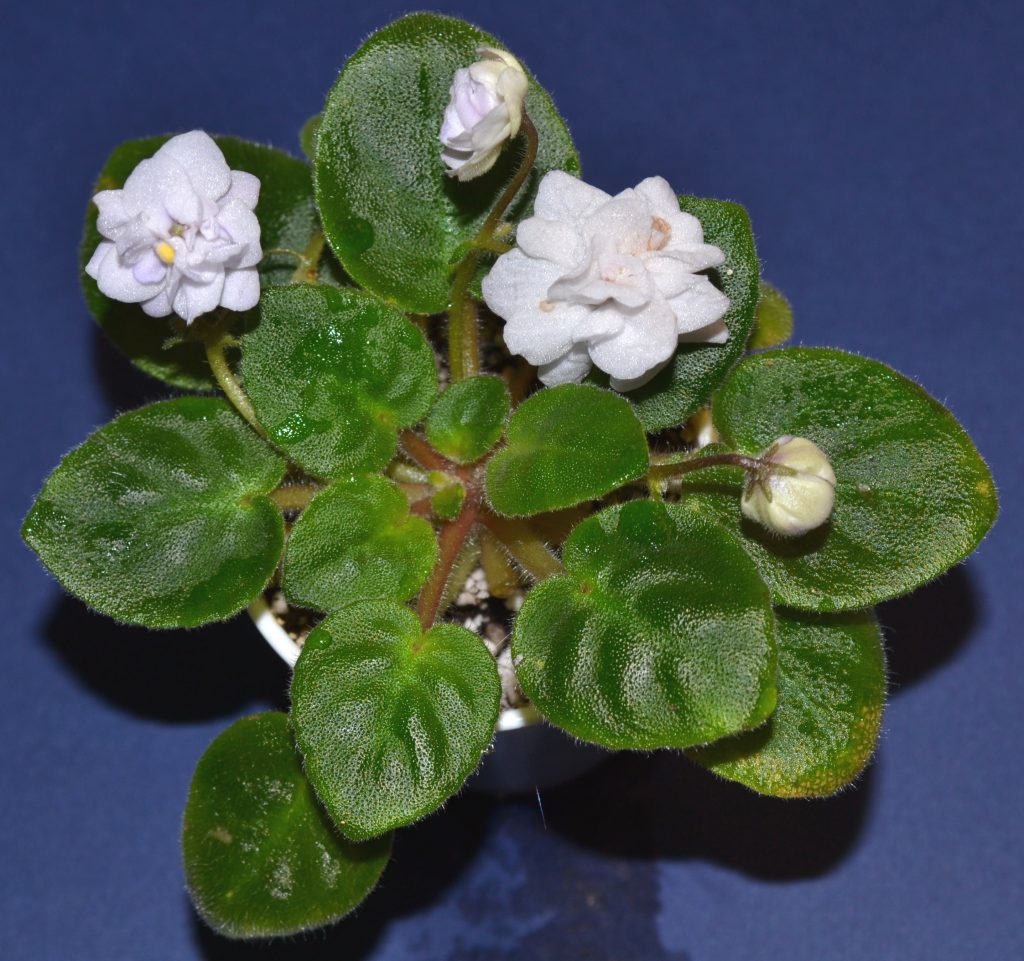
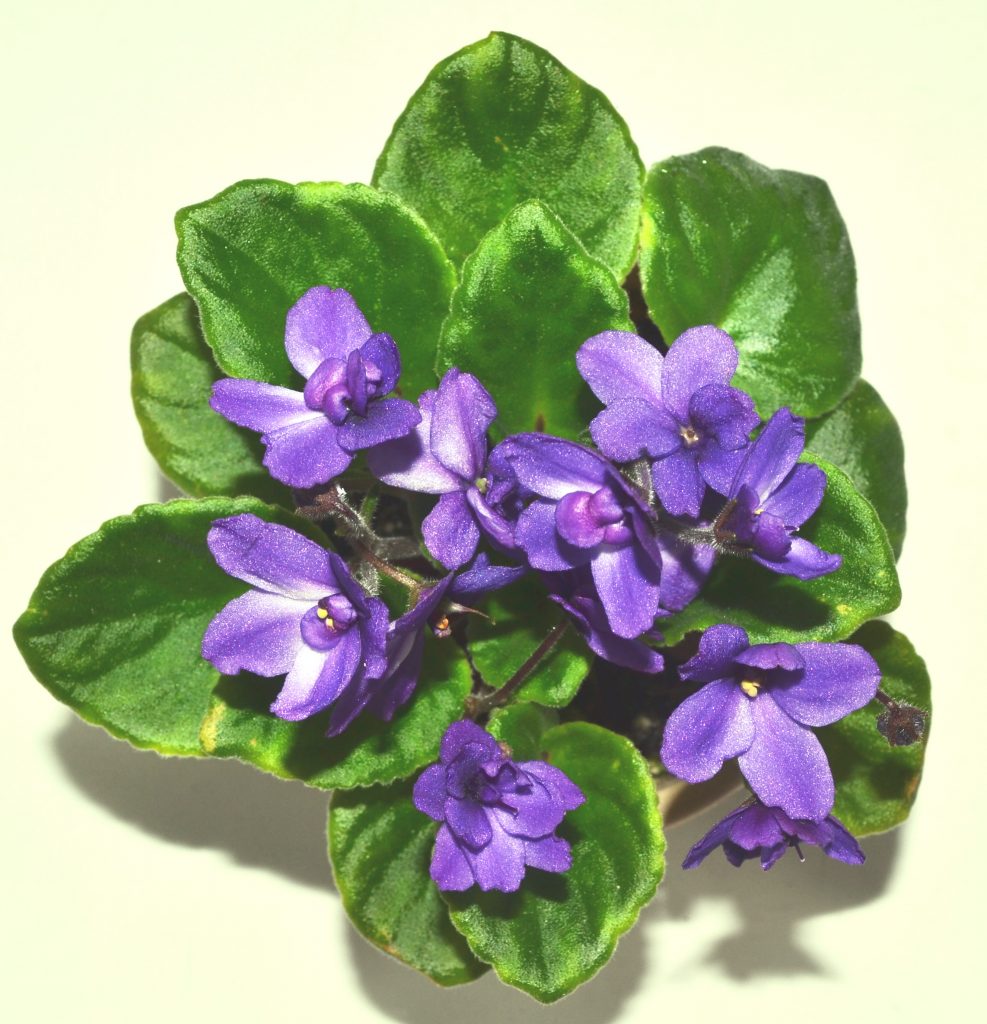
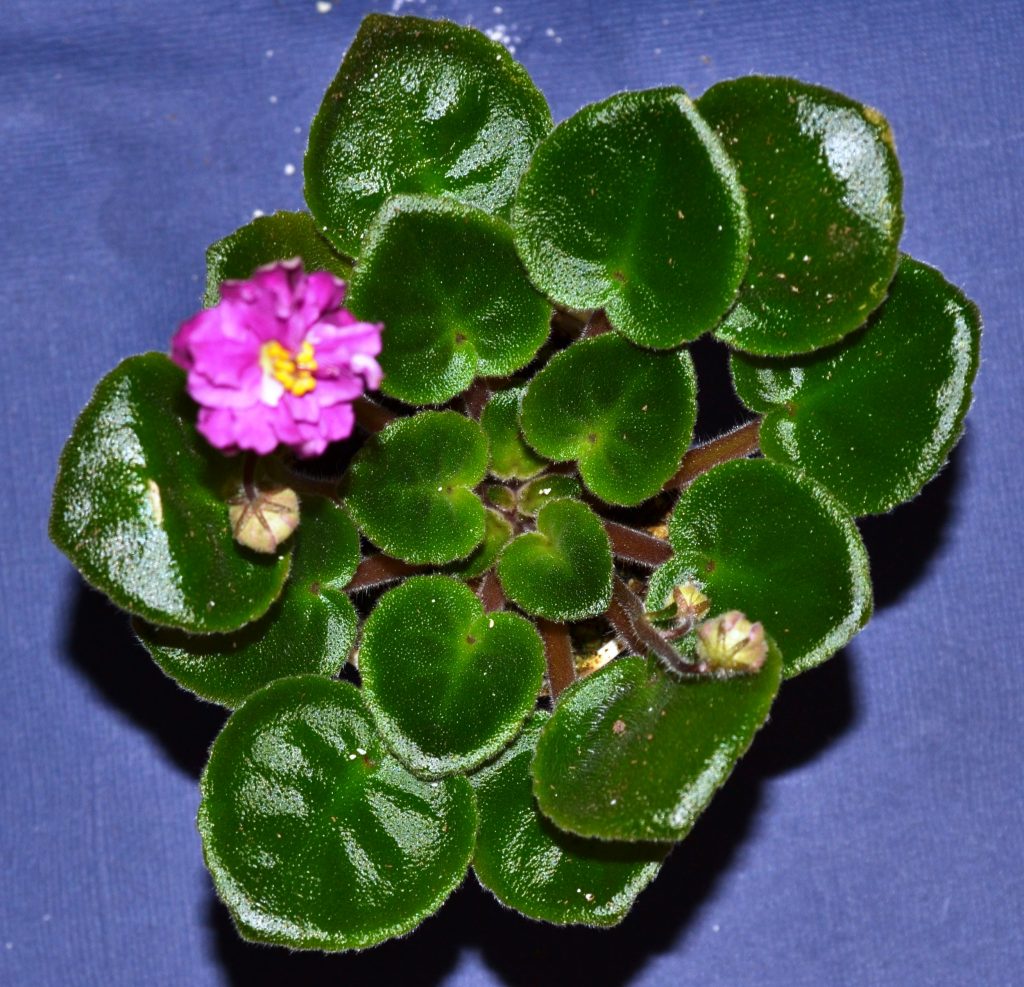
Grooming Habit I – Removing Flowers
- As soon as you notice faded, wilted, dried up or dead flowers gently remove both flowers and flower stalks from the African Violet plant.
- Sometimes you will notice empty flower stalks, where the flower has fallen down leaving behind the flower stalk.
- Remove these flower stalks. Also remove any fallen flowers on the soil or leaves of the plants.
- For the remaining healthy flower stalks, if they are hidden under larger leaves, you can gently move them above the leaves.
- As seen in below images, there are a few flowers and stalks which are hiding underneath larger leaves.
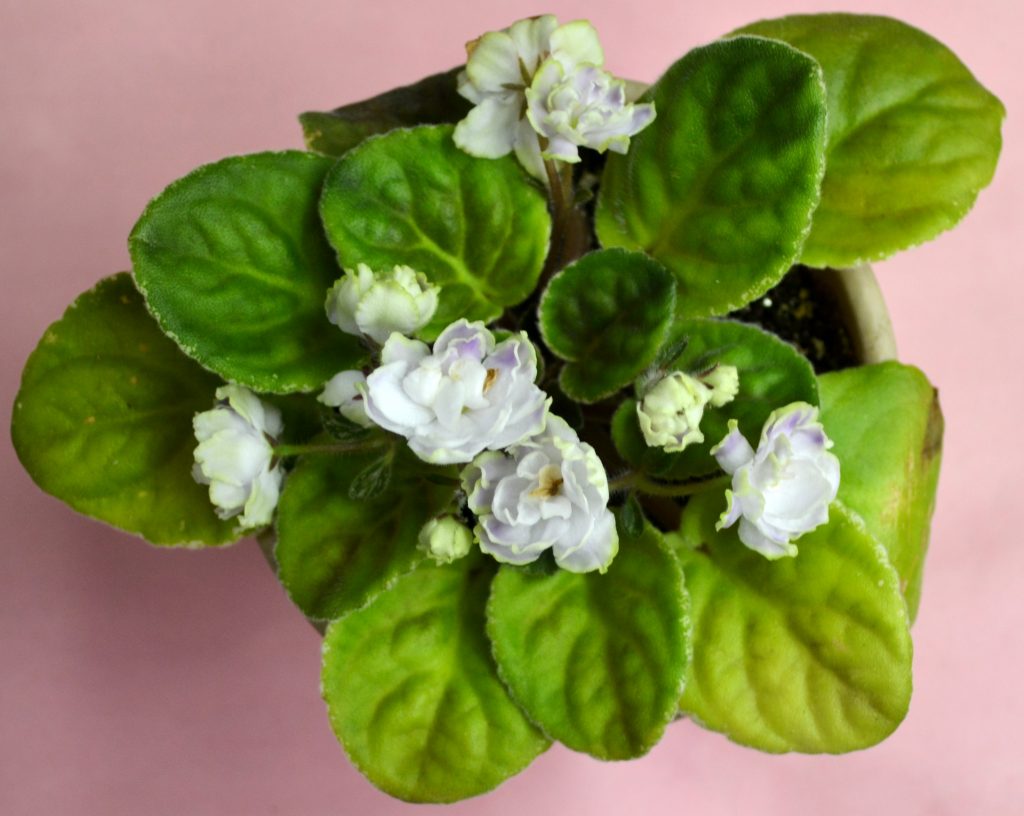
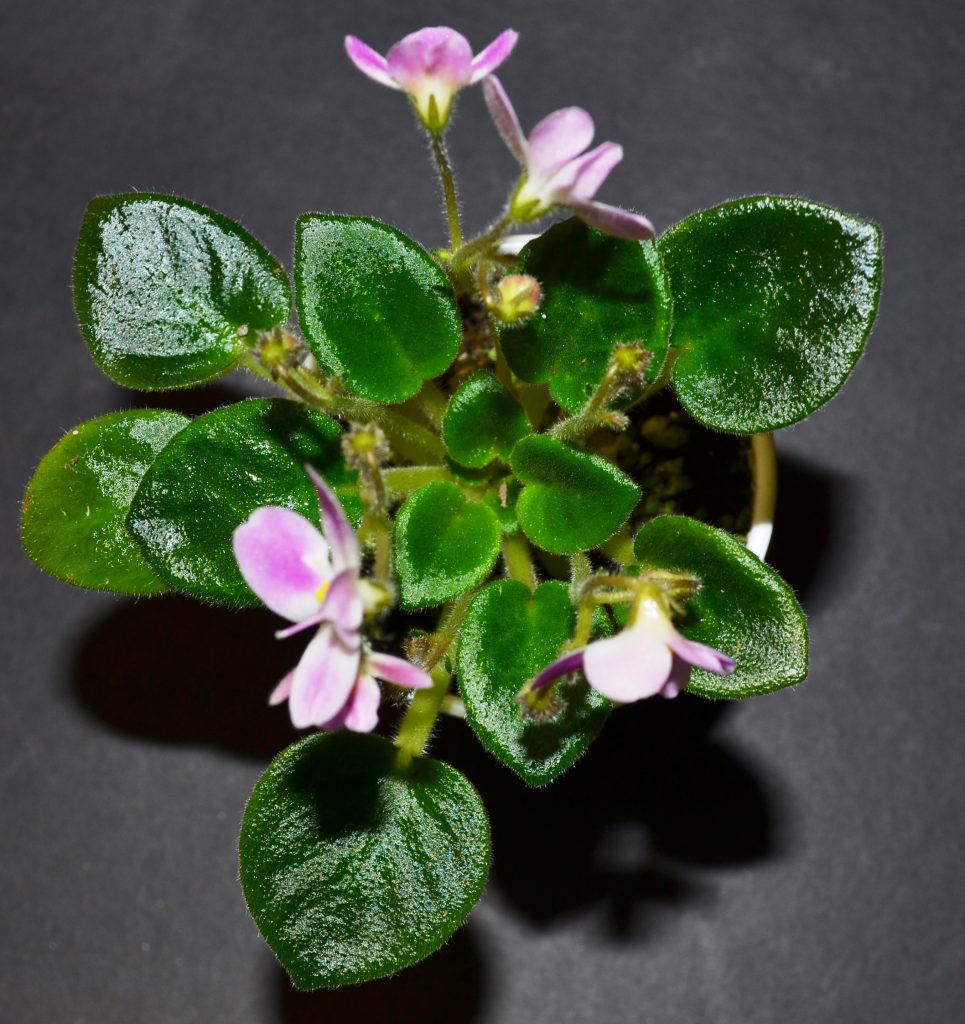
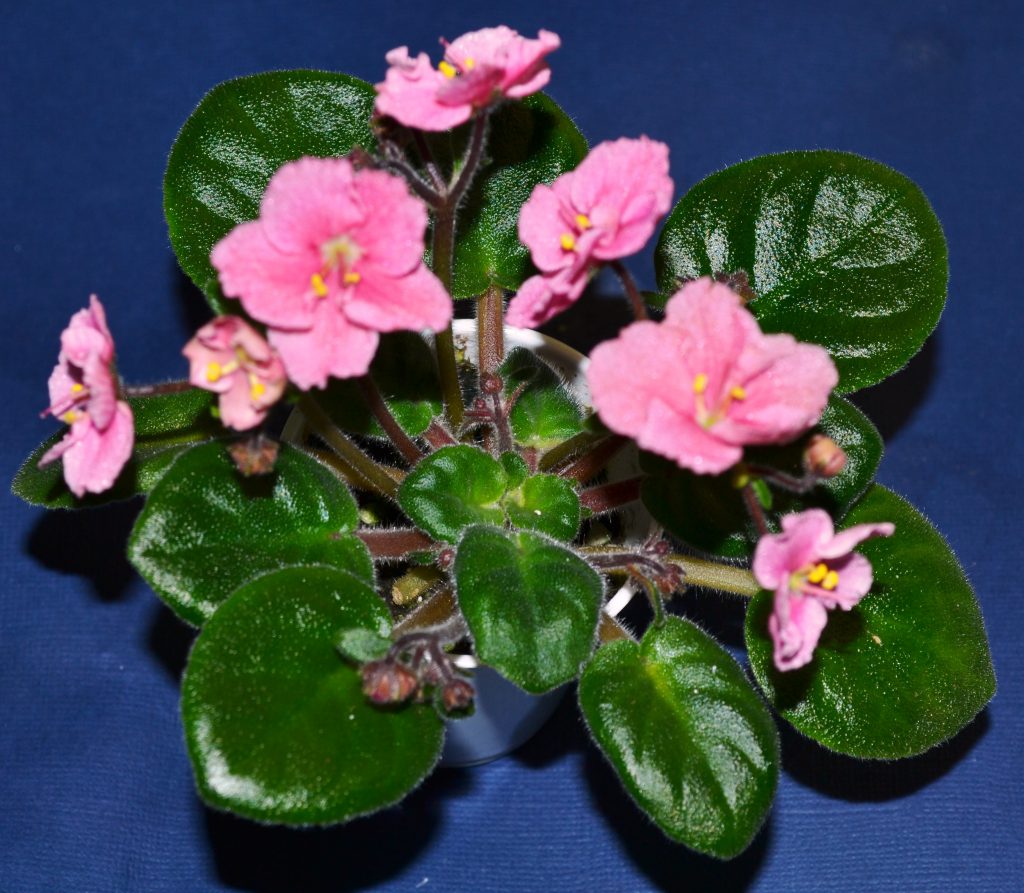
- Sometimes, you may find dried up flower buds too, they need to be gently removed along with its stalks.
- By removing these flowers and stalks, you will first prevent the occurrence of disease such as mold, powdery mildew or crown rot.
- Secondly, you will provide space through the plant for adequate air circulation.
- Finally, you will improve the visual appearance of the plant.
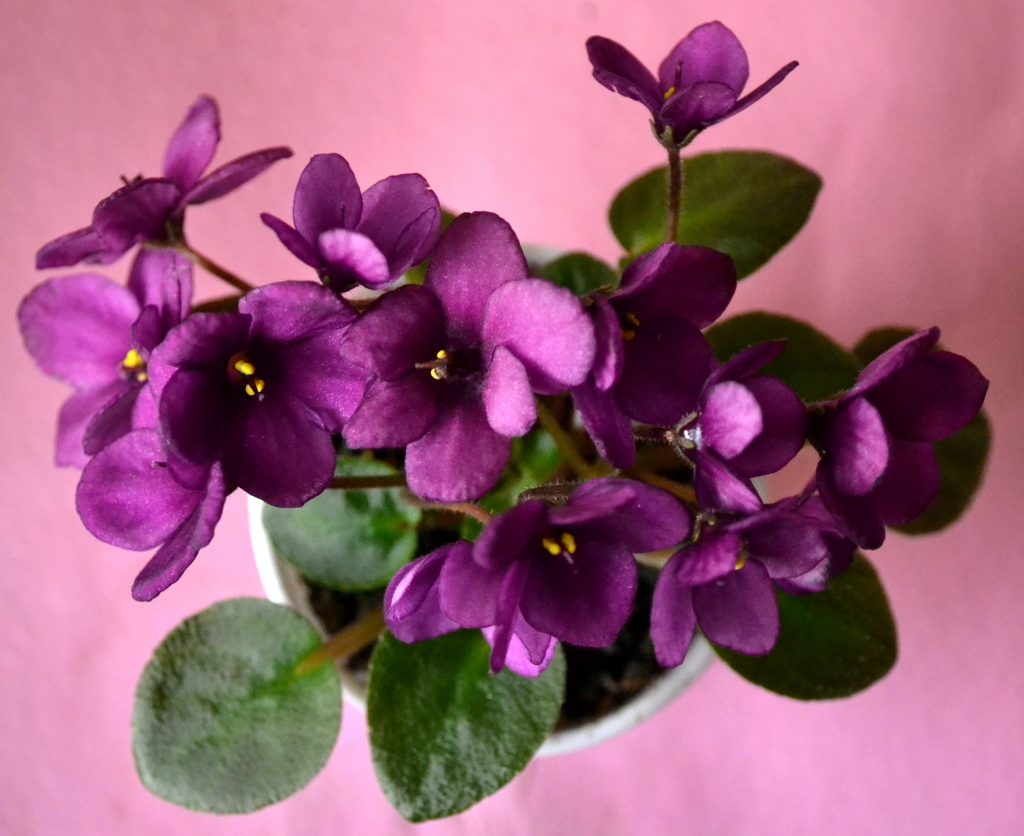
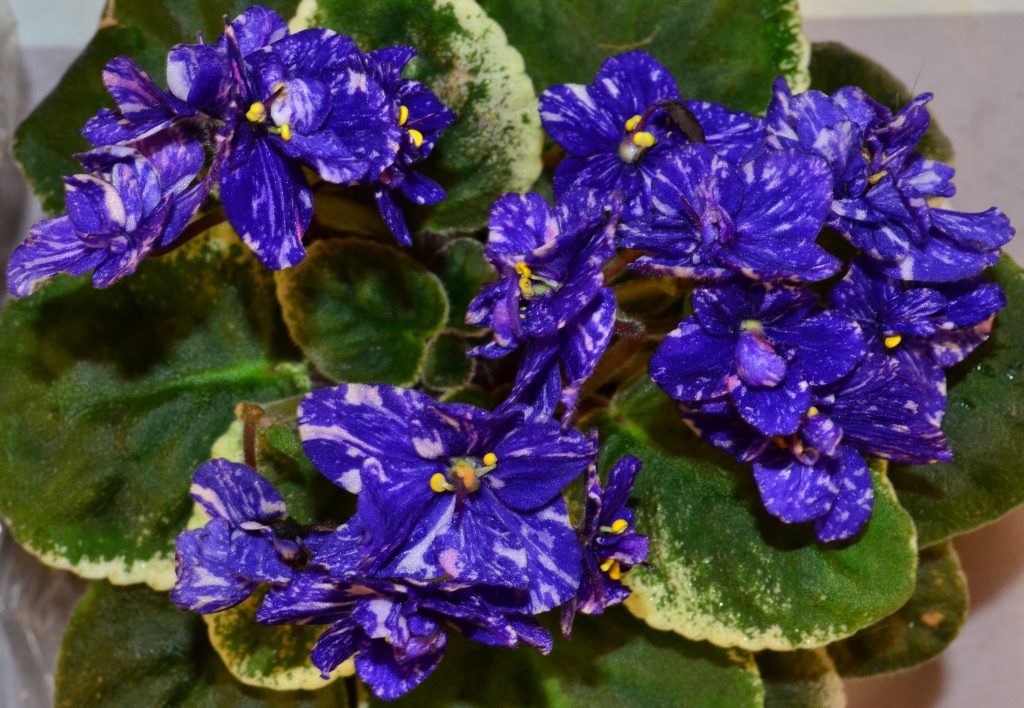
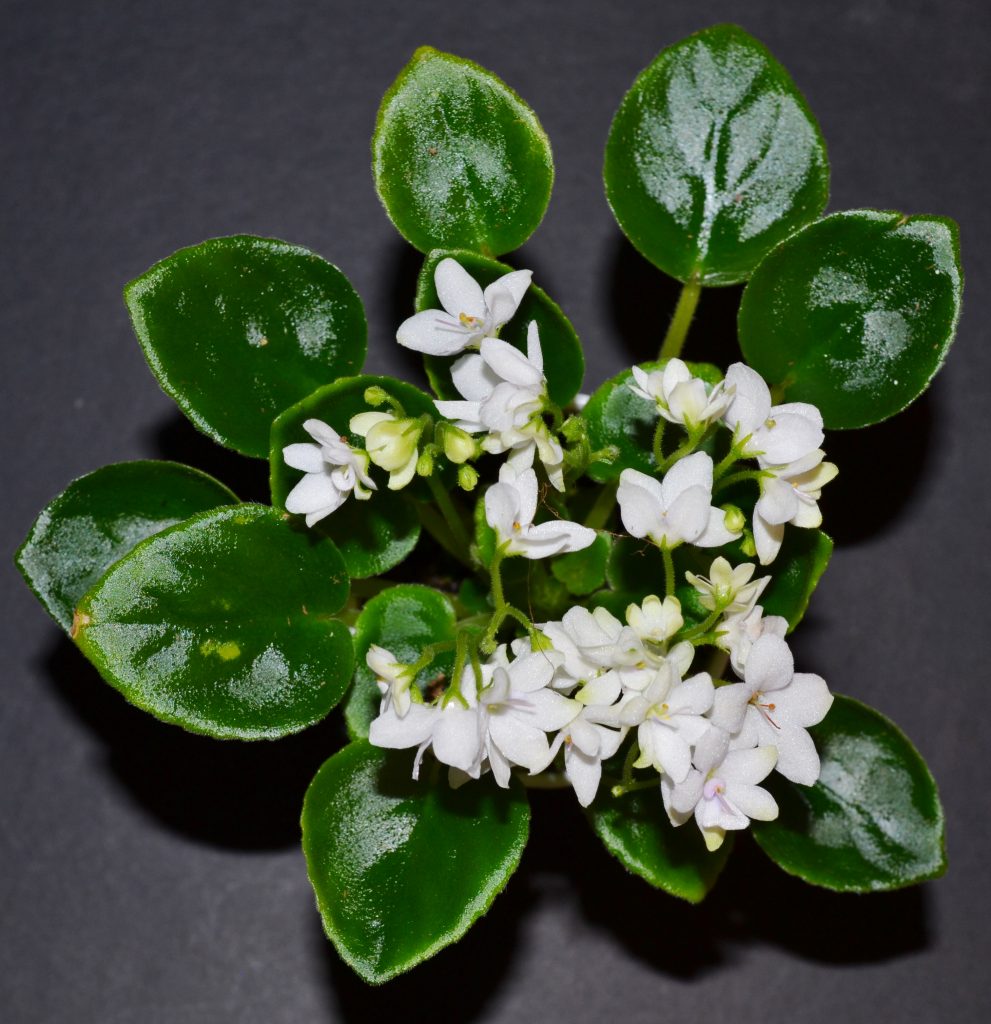
Grooming Habit II – Removing Leaves
- When you first inspect your African Violet plant remove the wilted, dried, shriveled, limp or dead leaves.
- Also remove leaves that have turned brown and/or are damaged.
- For more information on why African Violet leaves turn brown, can visit blog post, “Brown Leaves on African Violet Plants“.
- Next check for any tiny or smaller leaves hiding under the mature larger leaves.
- Remove these immature leaves, they take up undeserved space and energy from the African Violet plant.
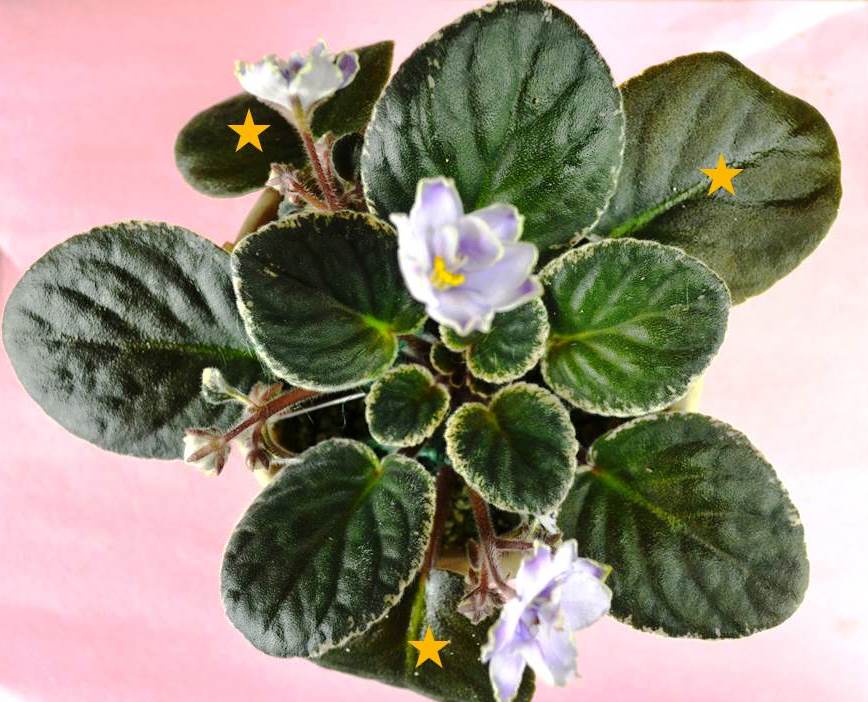
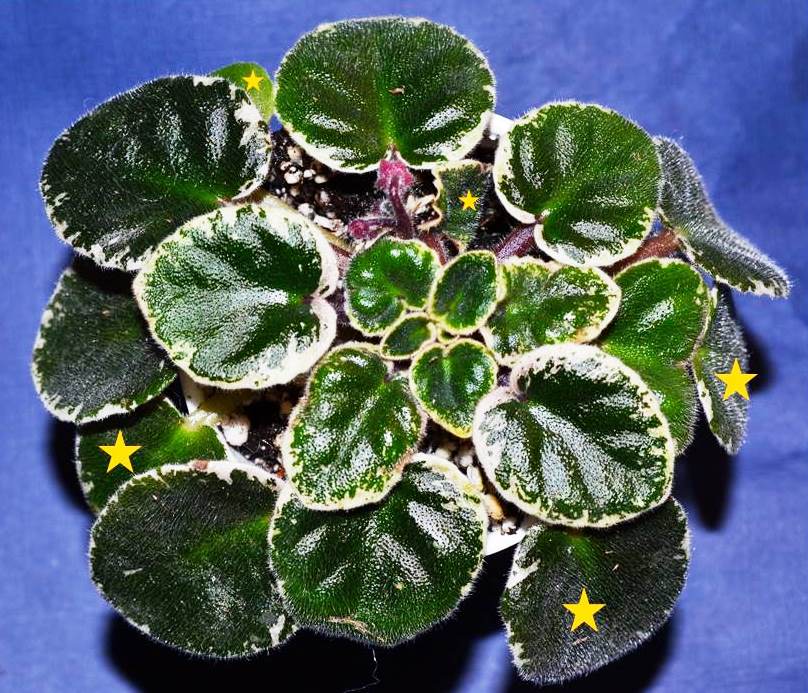
- If you have neglected your African Violet plant for a while and the violet has constantly grown with numerous rows of leaves, it is time to remove the outer older tougher row of leaves.
- These older leaves will have a pale, faded appearance compared to the inner row of leaves towards the crown.
- The older leaves will also be slightly tough or brittle to touch.
- For example, in the above two images, the leaves will yellow stars need to be removed, they are the older leaves.
Grooming Habit III – Checking for African Violet Suckers
- Each week or monthly when you inspect your plant, always check for suckers.
- If left unchecked suckers can ruin the symmetry of your African Violet plant making it grow lopsided.
- Suckers are diverge the energy needed from the main African Violet crown to grow towards itself.
- Suckers occur in between the leaf axis and grow as two sets of tiny leaves.
- I use a sucker plucker tool to remove these suckers.
- For more information on how to identify and remove suckers, can visit blog post, “African Violet Suckers: What Are They and Removal?“
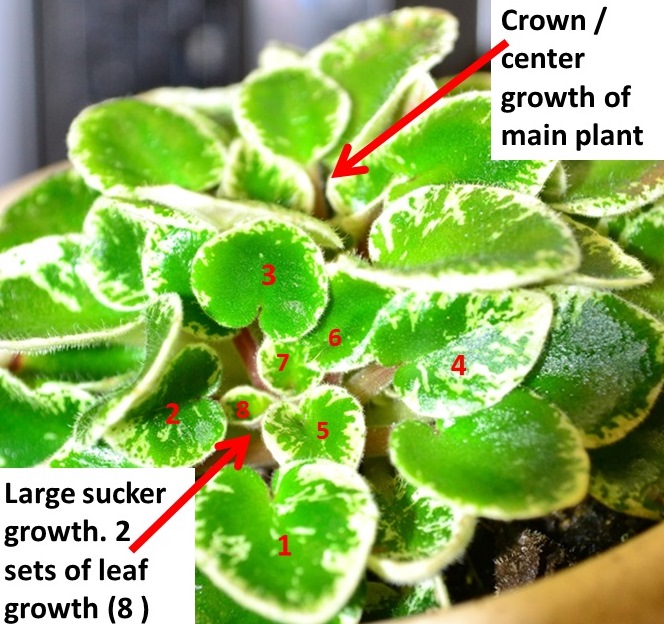
Grooming Habit IV – Spacing And Rotating African Violet Plants
- When African Violet plants are placed on your windowsill or stand make sure there is adequate space between the plants.
- This will ensure adequate air circulation and breathing space for the plants.
- If the plant leaves are too close to one another, they will start to curl inwards and ruin the symmetry of the plant.
- Once a week remember to turn the plant pot a quarter turn.
- This will allow light to reach the leaves evenly and maintain their symmetrical rosette form.
- For more information on growing African Violets in natural light, can visit blog post, “Natural Light for African Violet Plants“
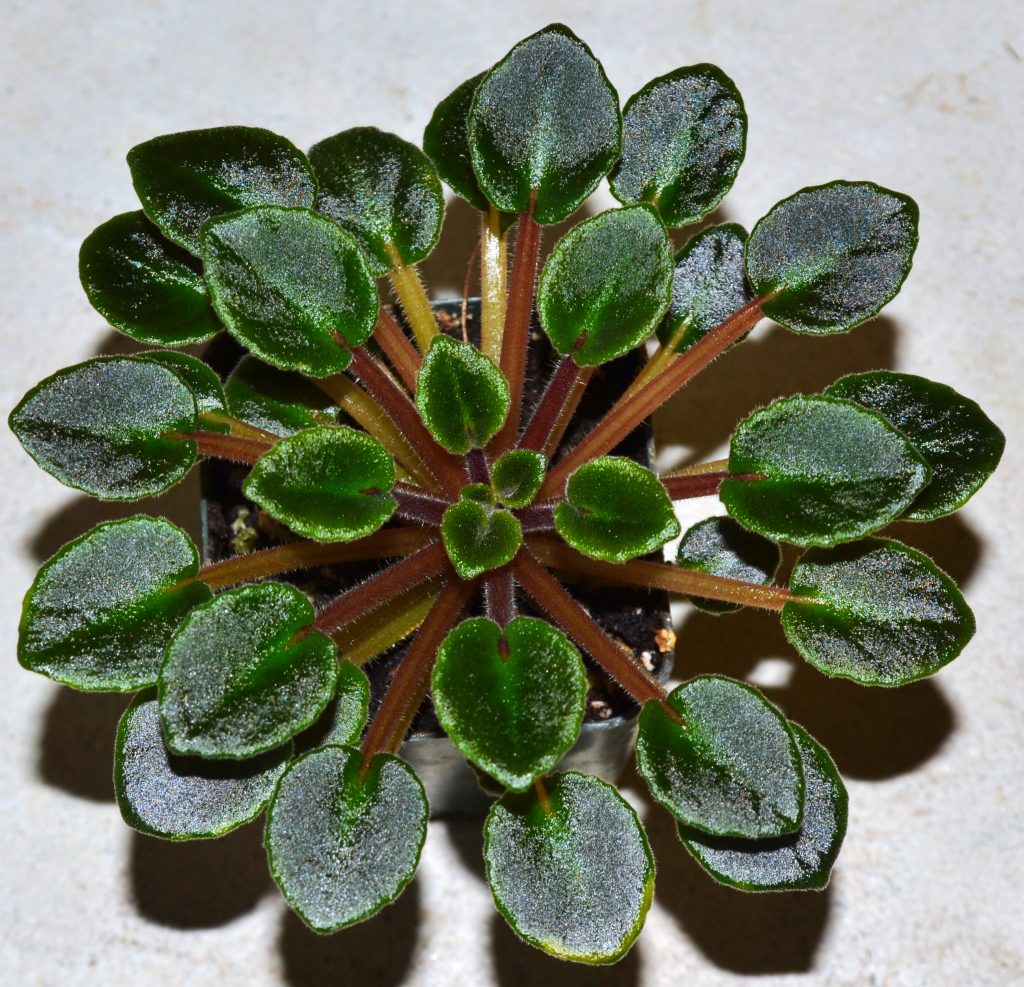
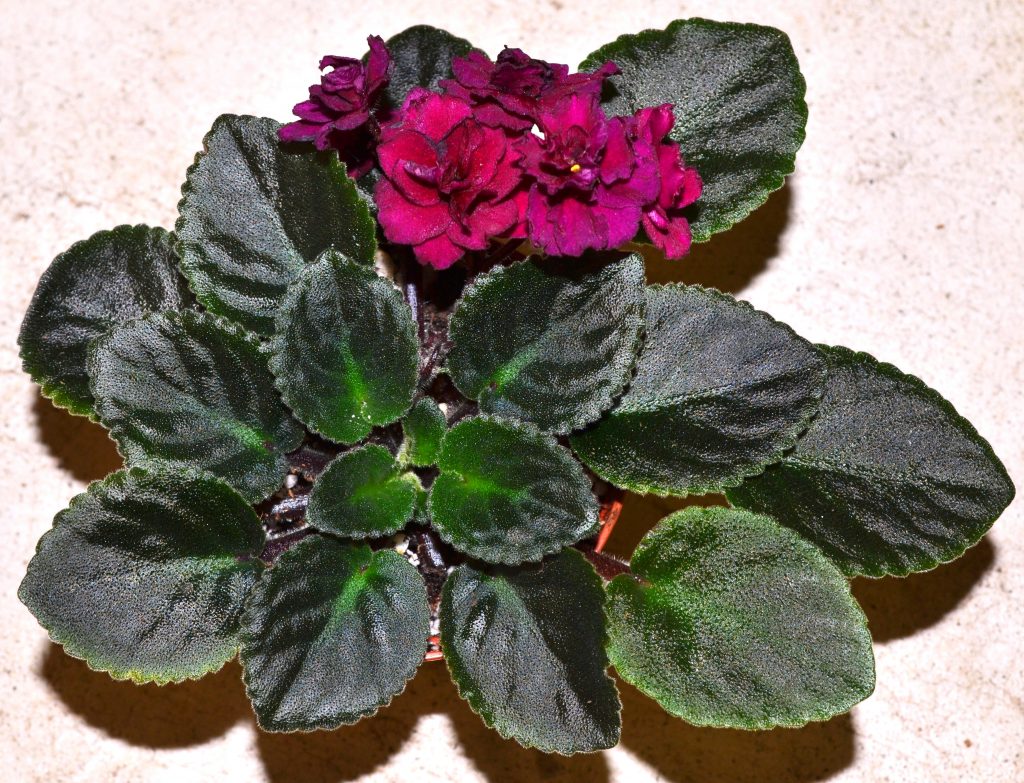
Tool recommendations below, useful in regular cleaning of African Violet plants.
Grooming Habits V – Cleaning African Violet Plants
- Over time dust and soil particles will accumulate on the African Violet plant.
- These particles can block the light reaching the leaves.
- Its good practice to once every few months to clean the dust or soil from the top of the leaves.
- Cleaning can be done either by using a paintbrush or a damp lint free cloth.
- When cleaning with a brush, use a soft bristle brush (like a make up brush) and gently brush away the dirt from the surface of the leaves.
- Do this step very carefully as African Violet leaves can get scarred easily.
- For the crown area, use a smaller sized brush.
- When cleaning with a damp cloth or soft sponge, first make sure all the water is squeezed out of the cloth/sponge.
- No dripping water should be visible.
- Use room temperature water or slightly warm not cold water.
- Then gently wipe the upper surface of the leaves.
- Make sure to clean any accumulated water. If left unchecked this can leave water spots on the leaves.
- Allow the plant to completely dry before putting pot back on the stand under lights or back on the sunny windowsill.
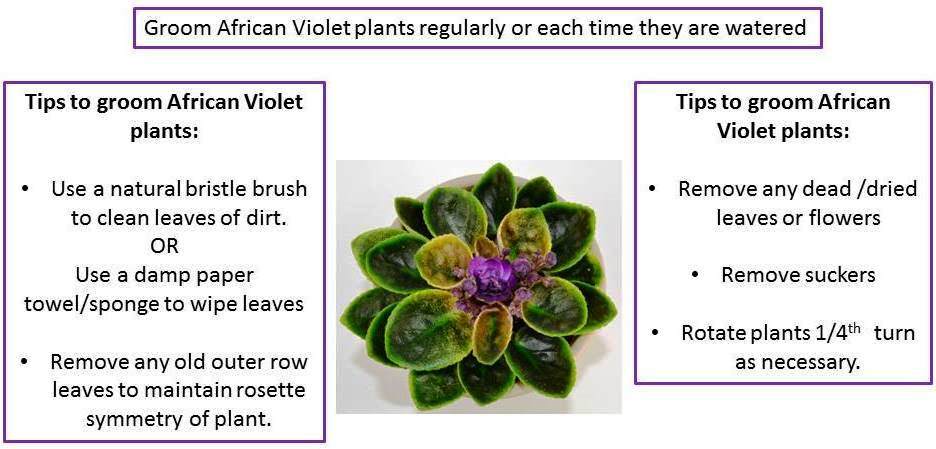
Below are recommendations of useful items used to clean African Violet plants
Grooming Habit VI – Inspecting African Violet Plants For Pests/Disease
- During your weekly inspection of African Violet plants, remember to inspect for any signs of pests /disease on the overall plant, leaves or flowers.
- Pests on the top surface of the plant most of the times will be clearly visible.
- If your African Violet plant is not doing so well and you have tried to optimize your watering, light, soil and fertilizer conditions, you can gently remove the soil mass from the pot and inspect the soil for any pests, such as silverfish, mealy bugs or mites.
- For more information about soil mealy bugs, can visit blog post, “Soil Mealy Bugs in African Violet Plants“.
- Diseases like powdery mildew are easily spotted on leaves/flowers.
- For more information about powdery mildew, can visit blog post, “Powdery Mildew on African Violet Plants“.
Grooming Trailing Plants
- Even though African Violet trailer plants do not have the typical rosette shape, they still need to be groomed.
- If the trailers are not regularly groomed, they can start to become misshapen.
- Not grooming can also lead to overcrowding and prevent new growth.
- If you have a large trailer plant with multiple crowns and haven’t ever groomed the plant, you can groom it back drastically to just one crown.
- Sometimes, this drastic grooming, will lead to a long neck visible on the plant. For more information on how to re-pot long neck, can visit blog post, “How to Bury and Re-Pot African Violet Bare Stems or Necks?“.
- This drastic grooming will encourage blooms and new growth.
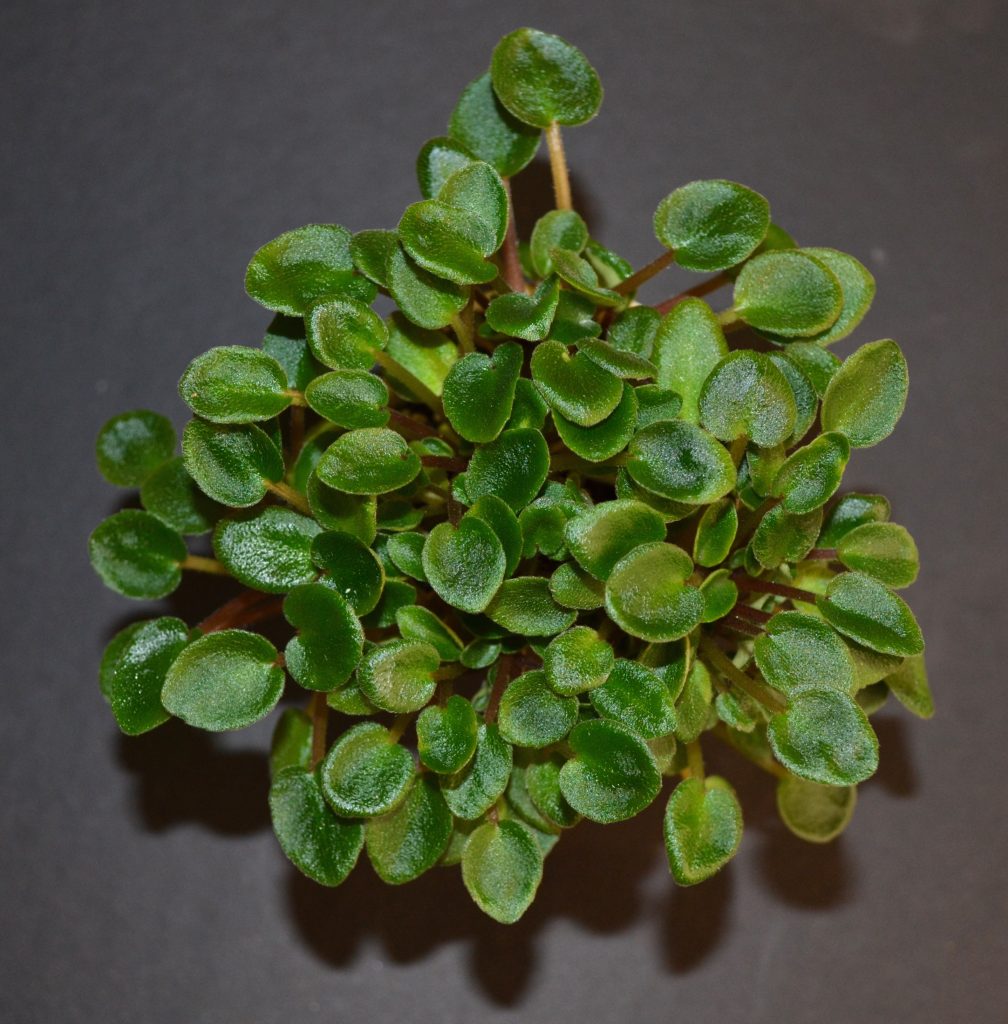
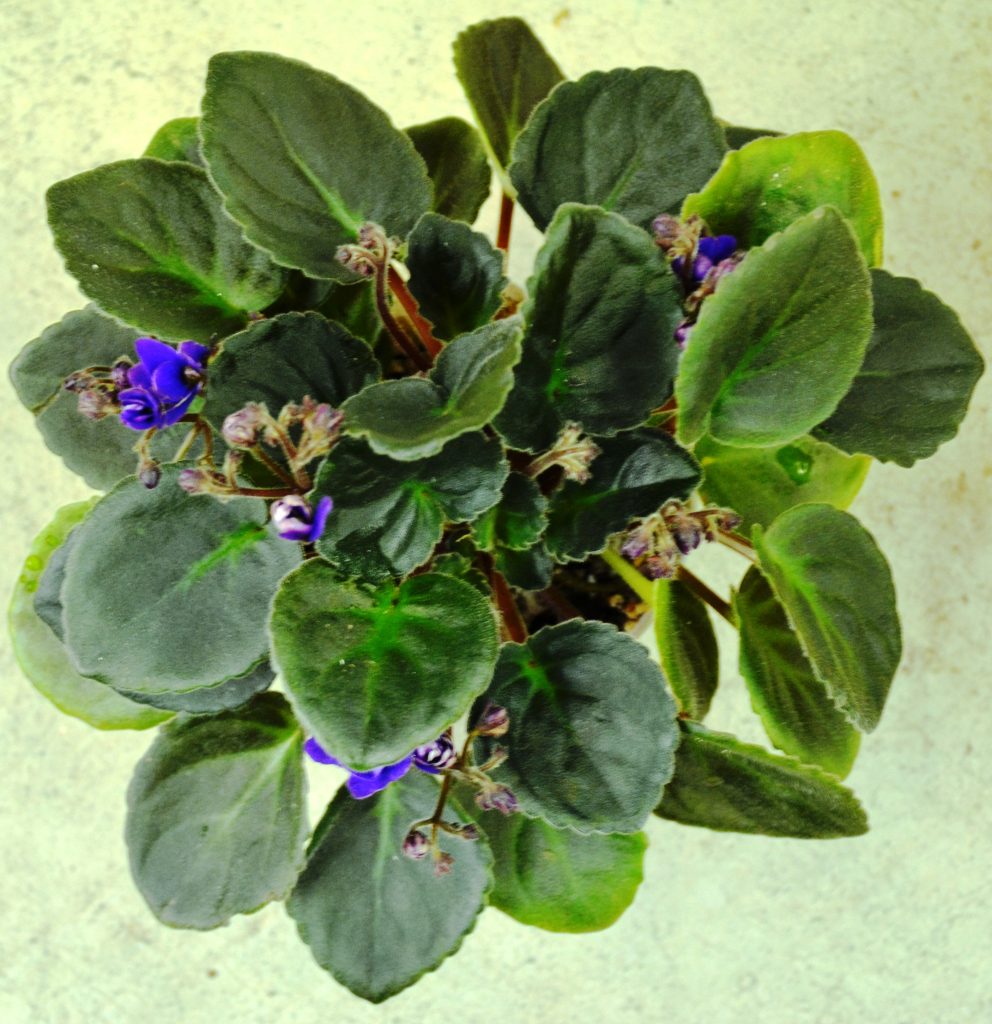
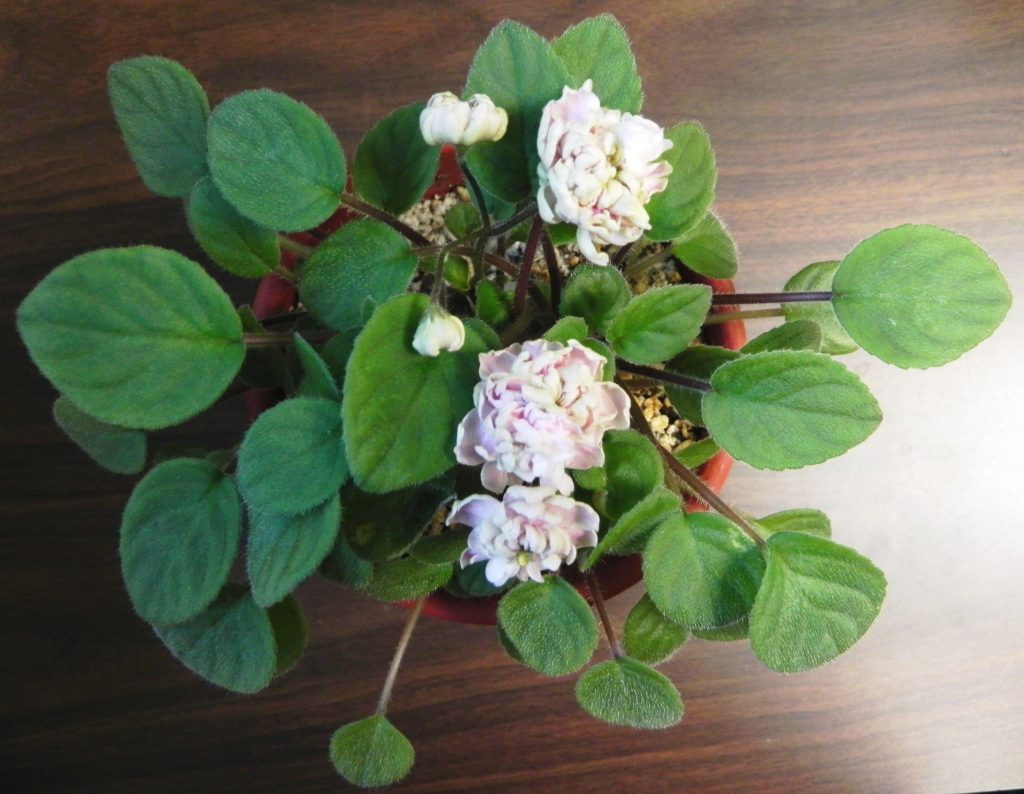
- If the trailer has only a few crowns which are slow in growth, first look for any new crowns beginning to form.
- Secondly, check around that new crown for any larger leaves which are blocking light or covering parts of the new crown.
- Finally remove those larger older leaves to allow the new crown more breathing space.
- Over time these smaller crowns will begin to fill up the plant and give a nice bushy trailer appearance.
Ceramic pots with different designs, can be used as a nice outer container for your African Violet plants as shown below:

*Our Affiliate Programs: We are a participant in the Amazon Services LLC Associates Program, an affiliate advertising program designed to provide a means for us to earn fees by linking to Amazon.com and affiliated sites.
Though we do link to many items on Amazon out of convenience to our readers, we do also participate in other affiliate programs that also pay us a commission for any purchases you might make through our links (at no additional cost to you!).
Like this article?
Share on Facebook
Share on Twitter
Share on Linkdin
Share on Pinterest



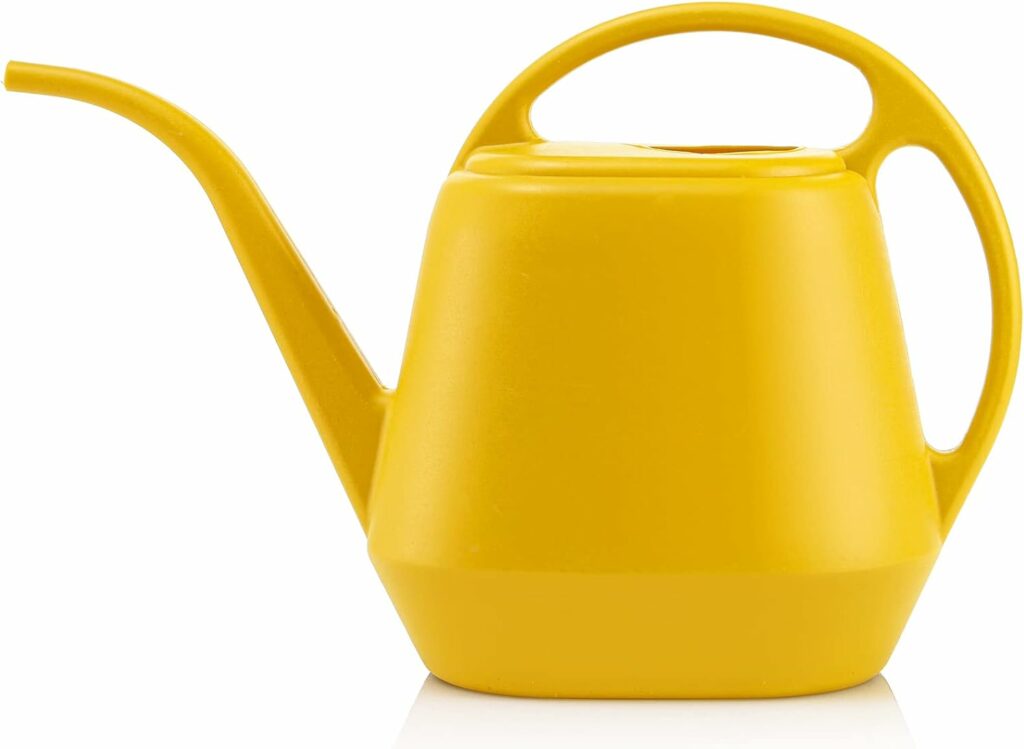

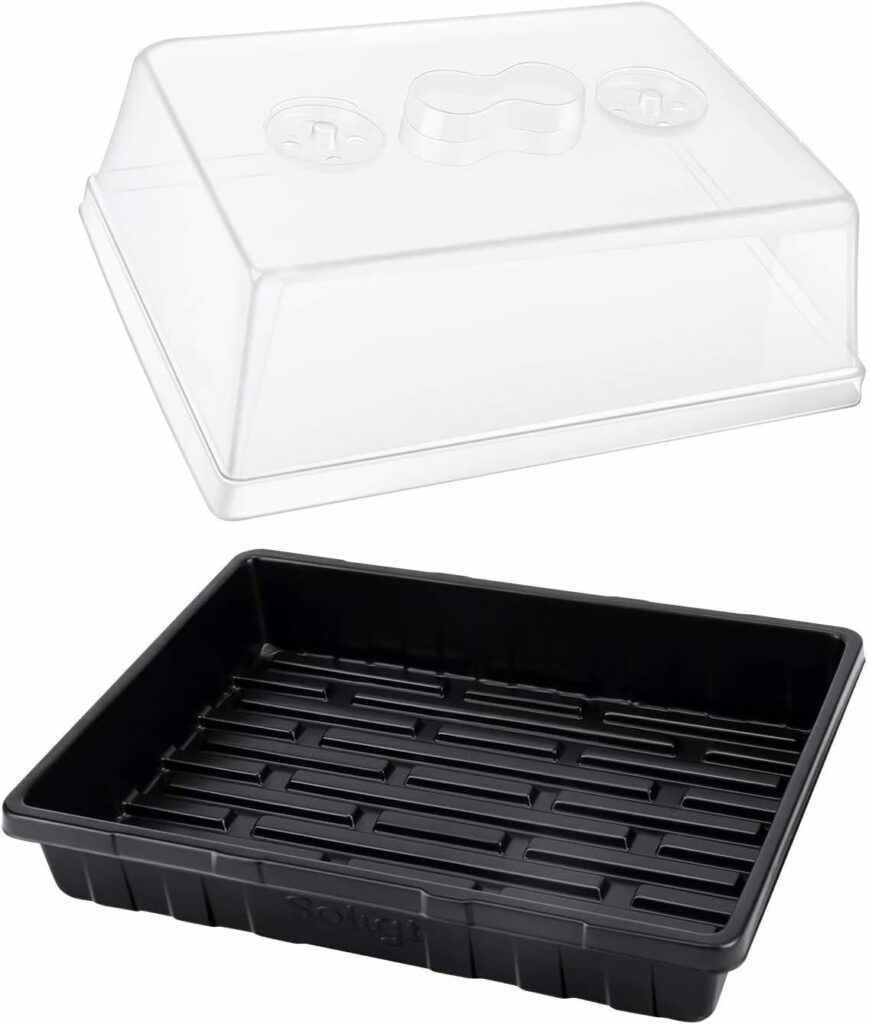


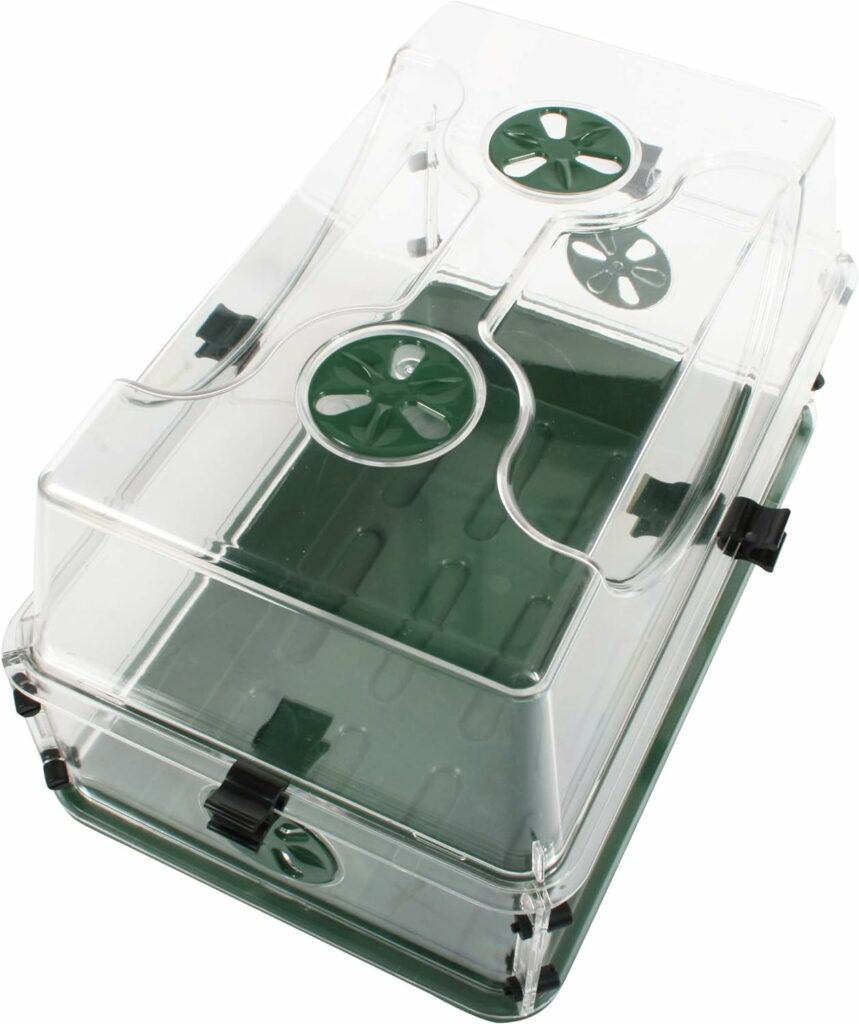


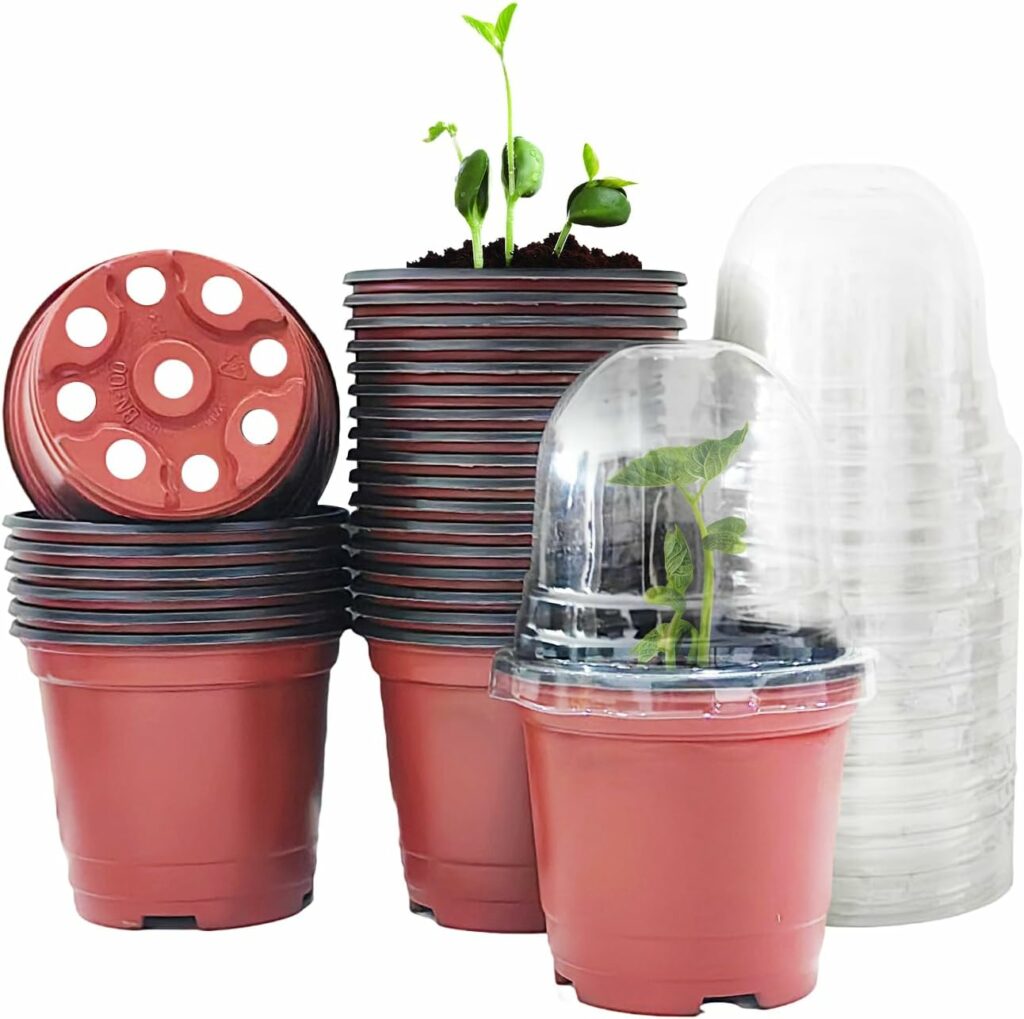
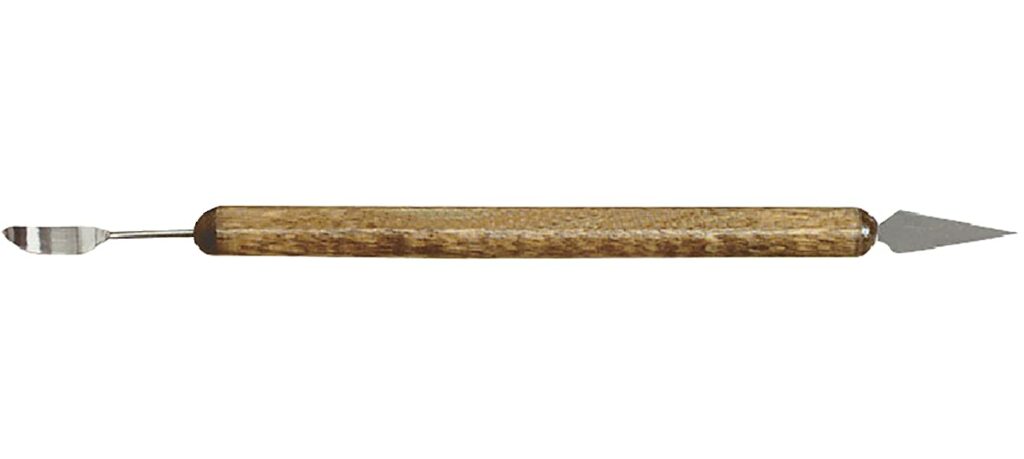



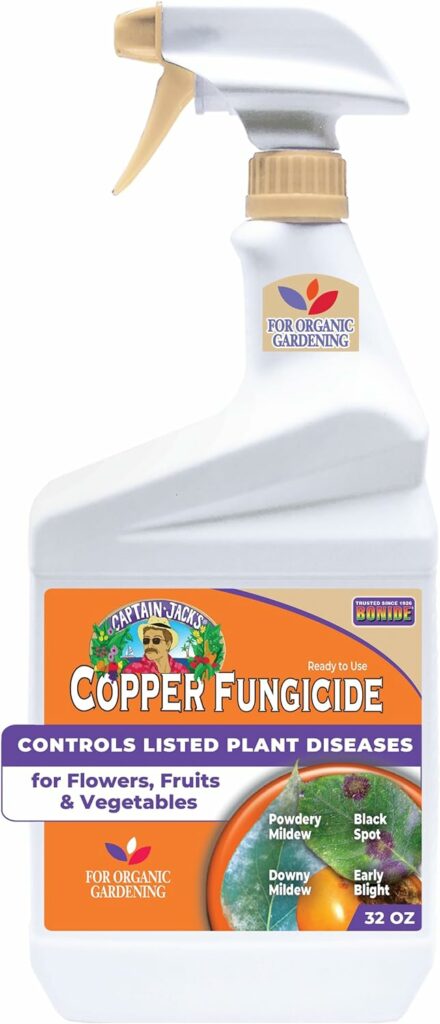
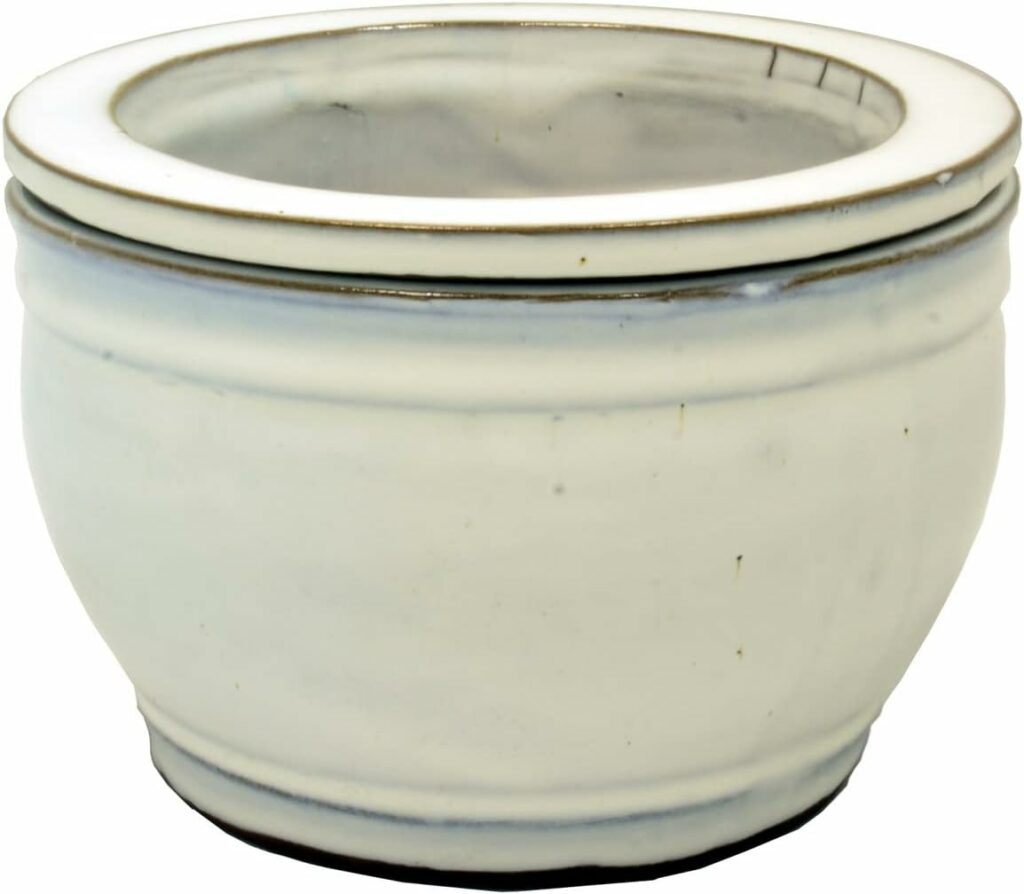
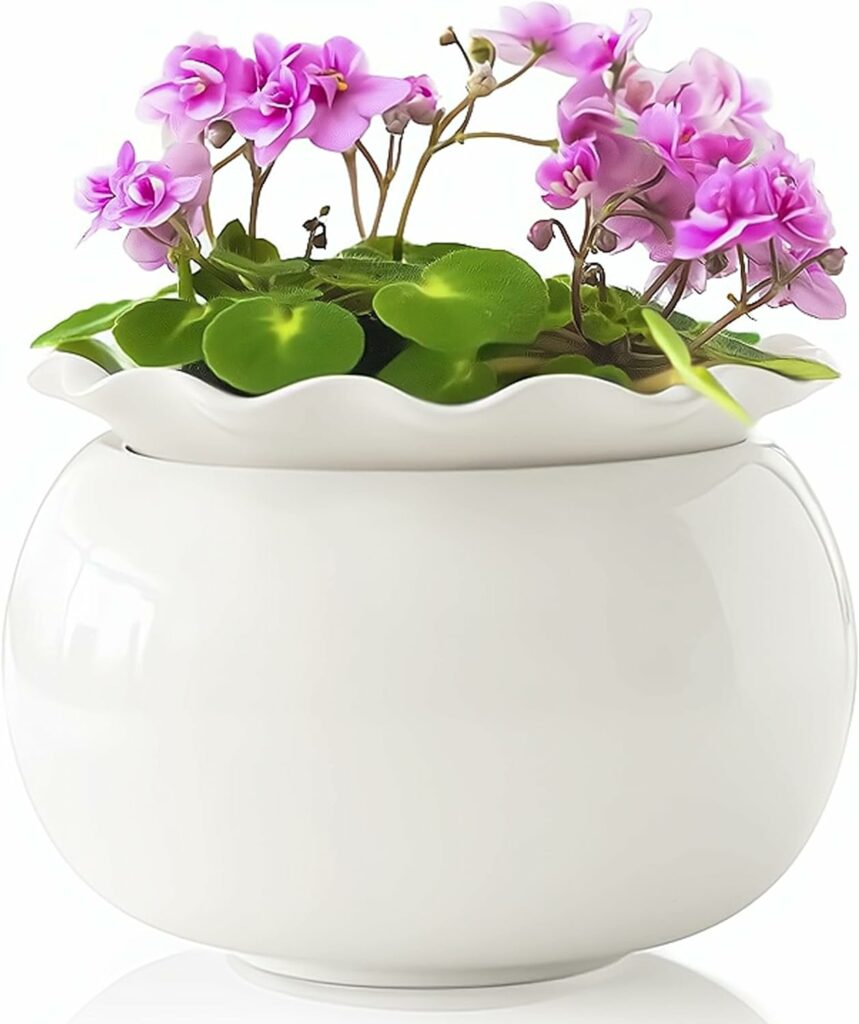
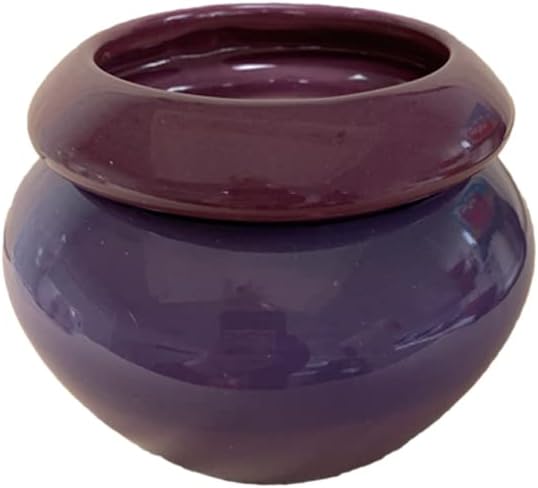
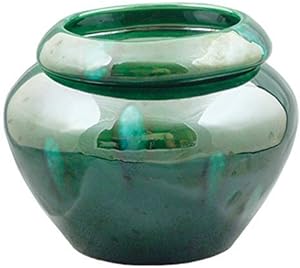

25 Responses
When starting a plant from a leaf, how long do you leave it in a zip lock bag.
Hello Sandra, thanks for your question. I would leave the African Violet leaf pot in a ziploc bag for 2-3 months or until you start to see tiny plantlets growing from the soil. If you start to see lots of condensation forming and the soil looks wet, then open up the bag slightly, to allow for air circulation. Once the African Violet plantlets start to grow and become an inch in height, you can remove the pots from the Ziploc bags. For more tips on African Violet leaf propagation, can visit my blog post at http://www.babyviolets.com/african-violet-leaf-propagation-how-to-produce-baby-plantlets/. Best of Luck! regards, BV
My plants are not flowering they seem to be healthy ,yet no flowers,i have them placed in large plate with small stones and bottom feed and rhey seem too like where they are placed,help!
Hello Susan,
thanks for your question. Regarding flowering, are you fertilizing your plants. It may be time for that. African Violets need a balanced fertilizer (14-14-14), around once a month. Can add 1/4 tsp in a gallon of water (or follow bottle/package instructions). Start with a diluted mixture, then can increase slowly. Other than that, if the plant has good adequate light and the surrounding area isnt too cold for the plant, then it should be fine. You can wait for the weather to warm up a little too. Let me know if you have any other questions. Hope this helps! BV
I put a tablespoon of peroxide in my violet pot dish water. A week later blooms galore.
The peroxide doesn’t kill them?
My plants just grow small leaves why?
Hi Linda,
thanks for your question. Is it a mini or semi mini variety, they usually grow smaller. If its a starter plant, it will take 3-4 months for the plant to grow out its leaves to maturity. If its a mature plant you have had for a while, are you fertilizing your African Violet plant regularly (usually 1/4 tsp of a balanced fertilizer per gallon of water). Maybe it needs a soil change, when was the last time you changed the soil for your African Violet. Hope this helps. BV
Years ago I found out a feather works for cleaning my AV leaves. I prefer an owl feather for softness.. The plants seemed to enjoy their cleanings!
Hello Debra, Thank you for that recommendation!
My one violet seems to be developing a very tight crown of multiple tiny leaves. It is normal looking in the outer leaves. I use a wicking method to water all of them Should I bag the plant to relax the crown?
Hello Deborah,
Was there a culture change in your violets, meaning, did you change the watering method, fertilizer or light. That can sometimes lead to tiny leaf growth in the center. Yes, you can bag it right now, until you isolate the problem. Sometimes the extra humidity can really help,
BV
I have a large African Violet that seems to be very healthy and blooms. From that one violet i have two offsprings that are attached but healthy and blooming. How do I divide them into three?
Hello Deborah,
thank you for your question. Seems, like you have suckers on your plant. First locate the center crown (the row of leaves from which each offspring grows), for both offspring. Using a sharp tool (sucker plucker – can find here, its half the price at the moment, https://amzn.to/36TuTj9 or scalpel, forcep), gently scrape off the offpspring at the point where it is attached to the main plant. You can then re-pot in a small mouthwash sized cup or similar. Place the pot in a sealed ziploc bag for a month and then open up for 2 weeks, put back on your plant stand. You can find detailed instructions of how to remove a sucker with pictures here, https://www.babyviolets.com/african-violet-suckers-what-are-they-and-removal/ Hope this helps, regards, BV
Hello Deborah,
Can I use the old leaves I’ve removed to propagate new plants?
Hello, yes you can use old leaves that you removed to propagate new plants. Choose leaves from the middle of the African Violet plant or the third row of leaves from the center of the African Violet plant. Leaves closer to the crown are considered younger/smaller leaves. The leaves towards the outside/edge/larger are older leaves. Younger / smaller leaves are still growing and may not survive through the propagation cycle. They are not suitable for propagation. Older leaves are woody with a tough stem and may take longer to root during the propagation cycle. This is from the post, http://www.babyviolets.com/african-violet-leaf-propagation-how-to-produce-baby-plantlets/. Hope this helps, regards, BV
I have an African violet whose leaves are growing upward rather that out from the stem. It blooms. What can I do
To get the leaves to grow out from the stem?
Hello Judy, thank you for your question. Seems like your plant is trying to reach for the light. Can try to move it to a sunnier location or a brighter location. Over time the leaves should spread out and open up. Sometimes if the plant is well rooted and in a very small pot, the leaves can get bunched up and tight, start growing upwards too. Hope this helps, BV
My African violet is over 5 years old and has produced the most wonderful flower displays (and offspring). Lately numerous leaves have become mushy and brown – I have groomed these repeatedly. My plant is in a self watering setup ie bottom fed via a submerged cord (overwatering most unlikely). The result is that the crown of my plant is now standing 35mm above the soil.
What should I be doing ?
Hello Geoff,
thank you for your question. I think it maybe time to re-pot the plant. If you have 4-5 rings of leaves and they all span out above the pot with the crown extending out, it could be re-potting time. If the plant has roots coming out from the bottom, top of soil or seems like a plan with a strong root ball, then you can remove it from the pot. Slice the root ball by 1-2 inches and re-pot the plant so the stem/neck of the plant sits deeper into the soil. If the plant does not have a long neck/stem and just a crown extending out, then you can remove the older outer 2 rings of leaves (if you have at least 5 rings of leaves) and scrape the neck a little after removing leaves and re-pot deeper into the soil. While re-potting, you can straighten out the plant too, if its lopsided or growing in one particular direction. The brown mushy leaves maybe due to old soil, if you have been grooming the plant, thats good too. Hope this helps. Regards, BV
How long does it take for a Leaf propagated African Violet to flower?
I have finally had success with growing African Violets and I am loving it! I have really enjoyed reading all your tips. Thank you
Hello Libby,
thank you for your question. I think it takes about 3-6 months for the baby violet to flower. It really depends on the variety of the plant, there’s no sure timing. Sometimes I have had plants take a whole year before blooming. I have found fertilizer definitely helps. Usually baby plants will start blooming in 2-3 months if they are well rooted and once they settle down in your new home. I would recommend the optimara fertilizer, it’s great for blooming, amzn.to/3oXUvCB. I add 1/4th of the powder packet in a 1/2 gallon jug. Hope this helps, regards, BV
My mother was excellent at African Violets and, at nearly 81 years old, I’m finally getting the knack!
Enjoyed the article